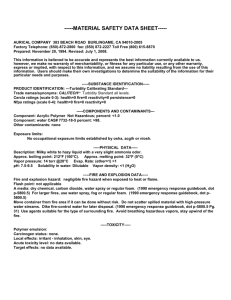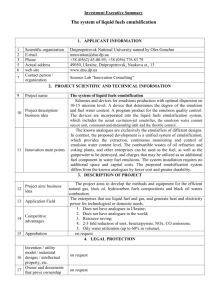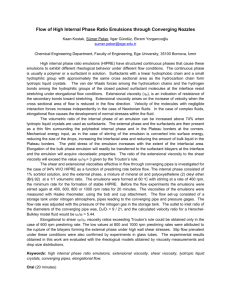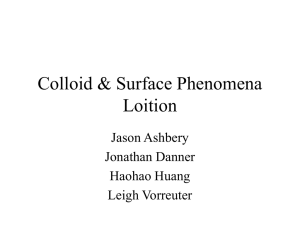Properties of emulsions
advertisement
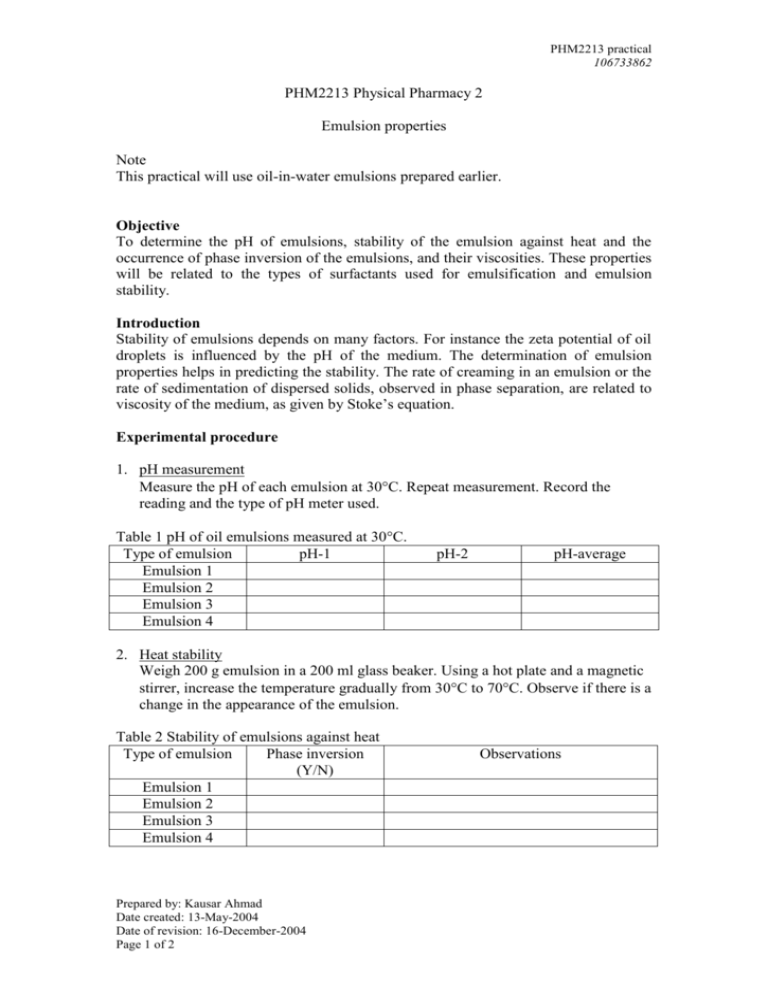
PHM2213 practical 106733862 PHM2213 Physical Pharmacy 2 Emulsion properties Note This practical will use oil-in-water emulsions prepared earlier. Objective To determine the pH of emulsions, stability of the emulsion against heat and the occurrence of phase inversion of the emulsions, and their viscosities. These properties will be related to the types of surfactants used for emulsification and emulsion stability. Introduction Stability of emulsions depends on many factors. For instance the zeta potential of oil droplets is influenced by the pH of the medium. The determination of emulsion properties helps in predicting the stability. The rate of creaming in an emulsion or the rate of sedimentation of dispersed solids, observed in phase separation, are related to viscosity of the medium, as given by Stoke’s equation. Experimental procedure 1. pH measurement Measure the pH of each emulsion at 30C. Repeat measurement. Record the reading and the type of pH meter used. Table 1 pH of oil emulsions measured at 30C. Type of emulsion pH-1 Emulsion 1 Emulsion 2 Emulsion 3 Emulsion 4 pH-2 pH-average 2. Heat stability Weigh 200 g emulsion in a 200 ml glass beaker. Using a hot plate and a magnetic stirrer, increase the temperature gradually from 30C to 70C. Observe if there is a change in the appearance of the emulsion. Table 2 Stability of emulsions against heat Type of emulsion Phase inversion (Y/N) Emulsion 1 Emulsion 2 Emulsion 3 Emulsion 4 Prepared by: Kausar Ahmad Date created: 13-May-2004 Date of revision: 16-December-2004 Page 1 of 2 Observations PHM2213 practical 106733862 3. Viscosity measurement Measure the viscosity of each emulsion using all spindles. Take readings after 60 seconds. Record the type of viscometer used, shear rates applied by using the different spindles and tabulate your results. Table 3 Viscosities of oil emulsions Spindle Shear rate No. (rpm) Emulsion 1 1 2 3 4 Type of emulsion Emulsion 2 Emulsion 3 Emulsion 4 Write a report and submit one week after the practical. Relate your findings in this practical to earlier work and answer the following in your discussion: 1. What is the reason for the different pH observed? 2. Upon heating the emulsion: a. Is the emulsion stable? b. Has a phase inversion occurred? i. If yes, at what temperature the emulsion appeared to destabilise? How do you justify this? ii. If no, why not? 3. Why is there a difference in the viscosity measurement when using different types of spindles? 4. What do you think will happen to the viscosity if the concentration of the oil phase is increased? 5. Is there a relationship between viscosity and particle size? 6. What is the effect of ageing on emulsion properties? Prepared by: Kausar Ahmad Date created: 13-May-2004 Date of revision: 16-December-2004 Page 2 of 2

